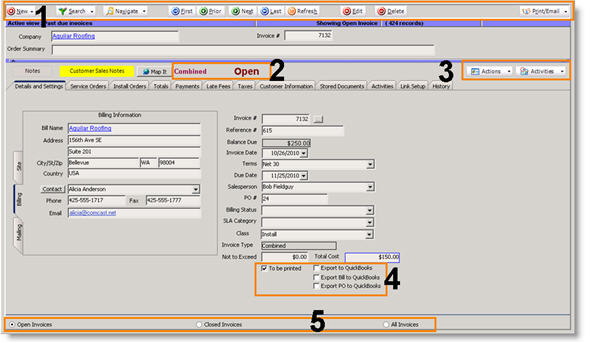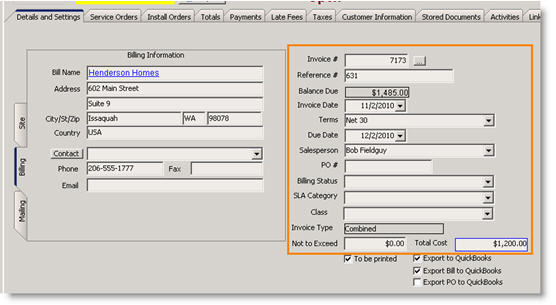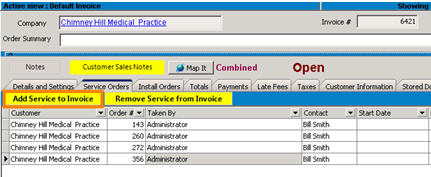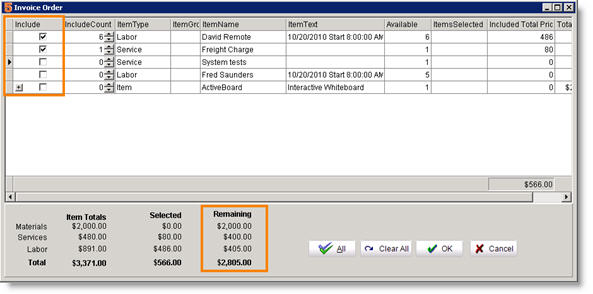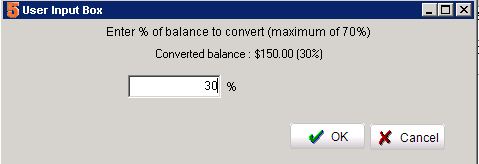Invoicing
The invoice will show the billing address, the balance due, the type of invoice, the orders associated with the invoice, the due date and more.
Invoice Orientation
Below are the different sections of an invoice. Depending on the permissions your SME Administrator created, you may not have access to all the areas described below.
|
1 |
New – create new combined or itemized invoice. Search – search open, invoiced or all invoices. Navigate – jump to invoice by invoice number or recently viewed invoices. First, Prior, Next, Last – tab through invoices. Refresh – refresh window to see calculated fields update. Edit – click to make changes to an invoice. Delete – click to delete the invoice (permissions needed) Print/Email – print or email the invoice. The printed invoices can be customized in the Reports module.
|
|
2
|
Invoice Status – Open or Closed.
|
|
3 |
Actions – Rollback invoice, apply deposit, post credit and more. Activities – set activities for the invoice (remind yourself or others to take action on the invoice)
|
|
4 |
To be printed – if checked the invoice is added to batch print. After the batch print is processed, you have the option to clear out all the “to be printed” flags. If syncing SME with QuickBooks, you will setup what will sync by default. Based on those settings, these check boxes will be automatically checked. Export to QuickBooks – If checked, the invoice hasn’t synced with QuickBooks yet. It will transfer on the next sync and the checkbox will be unchecked once synced. Export Bill to QuickBooks – If checked, the bill for the subcontractor on the invoice hasn’t synced with QuickBooks yet. On the next sync, the bill for the subcontractor will be added to QuickBooks. Export PO to QuickBooks - If checked, the purchase order for the subcontractor on the invoice hasn’t synced with QuickBooks yet. On the next sync, the PO for the subcontractor will be added to QuickBooks. |
|
5 |
Select a filter to view Open, Closed or All invoices then use the navigation to tab through the filtered view.
|
Details and Settings Tab
Invoice # - invoice number is generated based on the Next Invoice # in the Setup module. Reference # - The order number the invoice was generated for. Balance due- Calculated field showing the balance due on the invoice. Invoice Date – Automatically populated based on the date the invoice was generated. Terms – Invoice terms for that customer. Due Date – Due date based on the invoice date and the terms. PO# - If the order being invoiced has a PO number, the PO number will carry over to this field. Billing Status– If you are syncing SME with QuickBooks, the billing status will be imported from QuickBooks. You can use this field to void an invoice, or click Actions > Void Invoice. Make sure you uncheck Export to QuickBooks so SQLink doesn’t try to sync the voided invoice. Invoice Type – This field is not editable and shows the type of invoice (combined, itemized, partial, fixed, dollar amount, percent)
Types of Invoices
When creating a service or install order, select the Invoice Type. The type you select will change how the order is invoiced. Watch the video or read the description below.
<videoflash>b4ETBOoSBkU</videoflash>
Combined
This converts the entire order to a combined invoice. This is a good option for good tracking because all the details are in the order rather than replicated on the invoice. Below is a screenshot of a combined invoice. When you create a combined invoice, you cannot edit the individual items on the invoice. You can combine multiple closed orders into one combined invoice.
To add additional service and install orders to a combined invoice:
1. Select the Service Orders or Install Orders tab.
2. Click Add Service to Invoice or Add Install to Invoice.
3.The window that opens will display all of the open and closed orders with the invoice type of combined for that billing company. Double click on the order you want to add to the invoice.
4. You will receive this message: “The order has been fully invoiced. Close it?” Click Yes to close the order.
5. The order will be listed on the Service Orders or Install Orders tab.
Itemized
Converting an order to an Itemized Invoice will duplicate all the items on the invoice for further editing, providing more flexibility in changing the invoice after it’s created. Below is a screenshot of an itemized invoice. Notice all the tabs from the order are available in the invoice.
Partial
Selecting the invoice type of Partial allows you to select individual items on the order to include on the invoice. Generate multiple invoices for the order until all items on the order are invoiced.
When generating a partial invoice for an order, the Invoice Order window will open (image below). Here you can select which items you want to include in the invoice. At the bottom of the window, you will see remaining total to be invoiced.
- Click Clear All.
- For Service and Labor Items, check in the Include column to include the item on the invoice.
If you are select material to include on the partial invoice, you will need to expand the material line to select which material you want to include on the invoice.
- Click on the material line you want to include on the invoice (1 in image below).
- Check in the Include column (2).
- Make sure the Inc Count column has the right quantity you want to include on the invoice (3).
- Click OK.
Fixed Total
If you choose the invoice type of Fixed Total on an order, you can enter a fixed amount for material, labor and services. When you choose Fixed Total invoice type, SME adds an additional tab on the order called Fixed Rates shown in the image below. You enter in the fixed rates for labor, materials and services and the invoice generated will use this amount, not the itemized amount based on the labor, materials and services added to the order.
1. Create an order and on the Details and Settings tab select Invoice Type – Fixed Total.
2. Save the order and notice the Fixed Rates tab appears (image below).
3. Enter the fixed amount for labor, materials and services in the Fixed Amount column.
4. Add labor and materials to the order as you normally would. The Fixed Rates tab will show you your cost in the Item Cost column. Compare costs to your fixed rates by viewing the Item Profit column.
5. When you are ready to invoice the order, your customer will receive an invoice for the fixed amount set on the Fixed Rates tab.
Percent of Total
When generating an invoice for an order with % of Total Invoice Type, you will be prompted to enter the percent of the balance you want to convert.
Dollar Amount
When generating an invoice for an order with $-Dollar Amount invoice type, you will be prompted to enter the dollar amount you want to convert to an invoice. SME will allow generation of multiple invoices based on the dollar amounts. It will keep track of how much has been converted towards the total.
Invoice a Percent of a Fixed Invoice
If you setup a fixed invoice and you are ready to invoice the order, a fixed invoice will invoice the total order. If you need to invoice a percentage of a fixed amount, you will need to change the type of invoice to a percent or partial invoice and change the way you enter the items on the order.
1. Create a service item in SME called Service fixed total
2. Create a material item in SME called Material fixed total
3. Create a technician in SME called Labor fixed total
Now start adding the fixed total amounts to the order on the Order Items tab:
4. Select the Order Items tab on the service or install order.
5. Click New Service and select the Service fixed total item. Enter the fixed service total in the Price field. Enter 0 in the Cost field. Click OK.
6. Click New Material and select the Material fixed total item. Enter the fixed material total in the Price field. Enter 0 in the Cost field. Click OK.
7. Click New Labor and select the Labor fixed total technician. Enter the fixed labor total in the Unit Price field and make sure Billable Qty is 1. Enter 0 in the Scheduled Qty and Unit Cost fields. Click OK.
When you add labor, materials and services to the order, make sure you do not fill out the price field. Only fill out the cost field for these items. The only items on the order that should have prices in them are the three fixed total placeholder items you added. The partial or percent of total invoices generated will be based on the total of the three.
